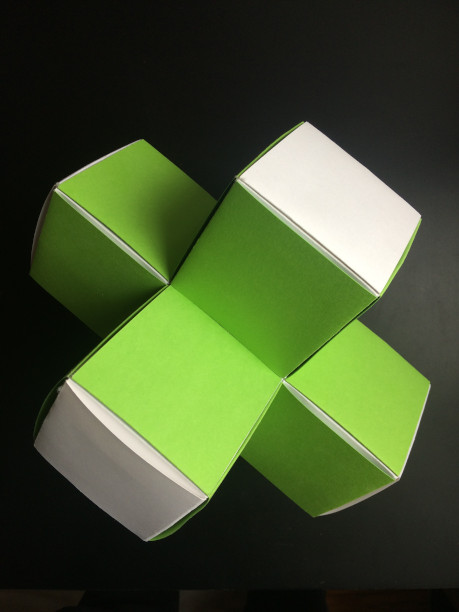Origami part 7 : Polycubes
Created on April 15, 2024.
Do you remember this post about polycubes ? I was making polycubes out of papers since at least five years before making the viewer. It all started with this video from Matt Parker's Youtube channel standupmaths : The Fractal Menger Sponge and Pi where he shares the project of building a Menger's sponge out of business cards.
A Menger's sponge is a famous example of a 3D fractal : take a cube (imagine a Rubik's cube) and remove the central cube on each face as well the small cube at the center, now you have a cube full of holes made of 20 smaller cubes. You can repeat this process on each of the smaller cubes. The Menger's sponge is the object obtained after an infinite number of repeating this process. It has zero volume and infinite surface area. In the real world though, such an object cannot be built, only some intermediary level can : level 0 is just a cube, level 1 is the first subdivided cube, etc.
The great things about this origami module is that it is very fast and easy to make, one can connect cubes together to make bigger shapes (polycubes) and one can with the same module, fill the faces to make the flaps disappear, making the shape stronger, flat and customizable.
Making a Menger's sponge by myself even at some intermediary level would take a long time because the number of paper sheets quickly rises (like exponentially), so making it would be quite the hassle and it would take a lot of space too. Quite recently, Matt Parker came with another video How many 3D nets does a 4D hypercube have? so I have added the nets to the polycube viewer. These shapes are much smaller and easy to make than the sponge. Another idea would be to make Tetris pieces (also known as polyominoes of length 4). In the end, I came up with a simple puzzle games, the Soma cube, a tree, a T-Rex and a abstract four-legged shape. I also thought of all making all the polycubes that span across a 3x3 cube but these were explored with the help of the polycube viewer (and there are too many). I have ideas for a few other shapes that I have stored in a voxel viewer but did not bother building for now.
The biggest structure I have made is the periodic table of elements with 118+15 (=133) cubes in total. Of course, I have made a program to customize the design of the elements cells to display the elements symbol, name, atomic number and mass. The good thing is that if you want to change the cell design add a new element or a property, it is easy to do so. I did not have to do it though since at the time of building (around 2018), the last discovered elements were already named: the naming ceremony for Moscovium (115), Tenessine (117) and Oganesson (118) was held in 2017. I have two regrets though, the table is quite large and it is flat so it does not show the full potential of using cubes for it instead of a poster.
Lastly, a simple idea would be to make cubes with the design of Minecraft blocks. It is the most played video game on the planet after all.






